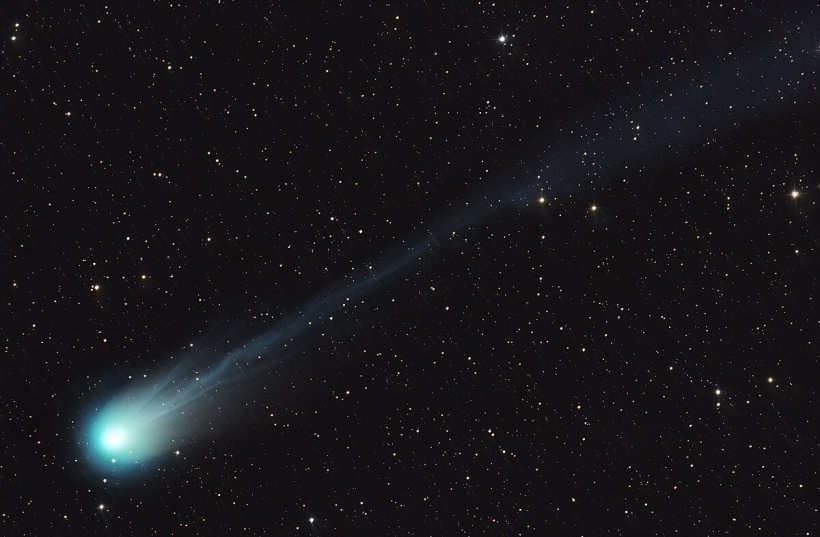Freshly unveiled images of the 'devil comet' 12P/Pons-Brooks precede its highly anticipated celestial display in the night sky this month. Recent photographs depict a swirling veil of frozen dust emanating from the comet's nucleus.
Comparable in size to Manhattan, this comet makes its appearance once every 70 years and holds the potential to captivate stargazers, possibly making an appearance during the solar eclipse on April 8th.

(Photo : Wikimedia Commons/Nielander)
Insights into 'Devil Comet' and Cryovolcanic Activity
Recent images depict a large icy sphere enveloped by a colorful swirling gas cloud around its core. Utilizing specialized software, astrophotographer Jan Erik Vallestad captured detailed close-up shots of the 'devil comet', which is currently approaching the Sun.
This comet, dubbed for its horn-like appearance, has intrigued astronomers with its periodic volcanic-like flare-ups, hinting at potential cryovolcanic activity. Due to solar radiation, the comet's nucleus-comprising rock, dust, and frozen gases-develops fissures, releasing cryomagma-water, ammonia, and methane-into space. Astrophotographer Juris Sennikovs also observed a similar spiral pattern around the comet's core, reinforcing the findings.
Visibility of the comet is currently limited to telescopes or binoculars, with its observation possible in the western sky towards the Square of Pegasus. As it moves towards the Aries constellation, there's a possibility of its brightness increasing enough to be visible without optical aids.
These fluctuations in brightness, indicative of its icy composition reacting to solar heat, offer scientists a unique opportunity to study its chemical composition and behavior during this rare visit, occurring only once every 70 years.
The comet's recent brightness fluctuations have intrigued scientists, indicating potential cryovolcanic activity. These volcanic-like flare-ups, triggered by solar radiation, cause the comet's nucleus to develop fissures, releasing cryomagma into space. Astrophotographer Juris Sennikovs corroborated these findings, observing a similar spiral pattern around the comet's core.
With the comet's next appearance scheduled for 2095, scientists are eager to utilize advanced technology and telescopes to study its chemical makeup and behavior. These periodic visits offer invaluable opportunities to deepen our understanding of cometary phenomena and the mechanisms driving their activity.
Additionally, the comet's recent fluctuations in brightness serve as valuable indicators of its reaction to solar heat, shedding light on its composition and evolution over time.
READ ALSO: Massive Devil Comet That Recently Exploded Poses No Threat to Planet Earth, Researcher Claims
'Devil Comet' Could Become Visible During the Total Solar Eclipse
The 'devil comet' completes a 71-year orbit around the sun, classifying it as a Halley-type comet. Presently, only those equipped with powerful telescopes can observe it. However, this is expected to change as the comet reaches its perihelion on April 21, potentially becoming visible to the naked eye during the total solar eclipse on April 8.
Experts anticipate a significant increase in the comet's brightness leading up to the eclipse, with the possibility of it becoming visible without optical aids. The comet is renowned for its unpredictable surges in brightness, and if one of its ice geysers erupts, the ejected material could reflect sunlight, enhancing its luminosity. This event could transform the comet into a spectacular sight.
During the total solar eclipse on April 8, observers will have the opportunity to witness the sun's corona when the moon completely obscures its disk. Additionally, the two brightest planets, Venus and Jupiter, are expected to become visible on either side of the sun. If comet Pons-Brooks reaches sufficient brightness, it may be visible between Jupiter and the sun, adding to the celestial spectacle.
RELATED ARTICLE: Devil Comet's Explosive Pattern: City-Sized Space Rock Erupts Every 15 Days
Check out more news and information on Space in Science Times.


![Earth's Quasi-Moon Kamo‘oalewa Could Originate From Lunar Surface Not Asteroid Belt [Study]](https://1721181113.rsc.cdn77.org/data/thumbs/full/53275/89/56/50/40/earths-quasi-moon-kamo-oalewa-could-originate-from-lunar-surface-not-asteroid-belt-study.png)











